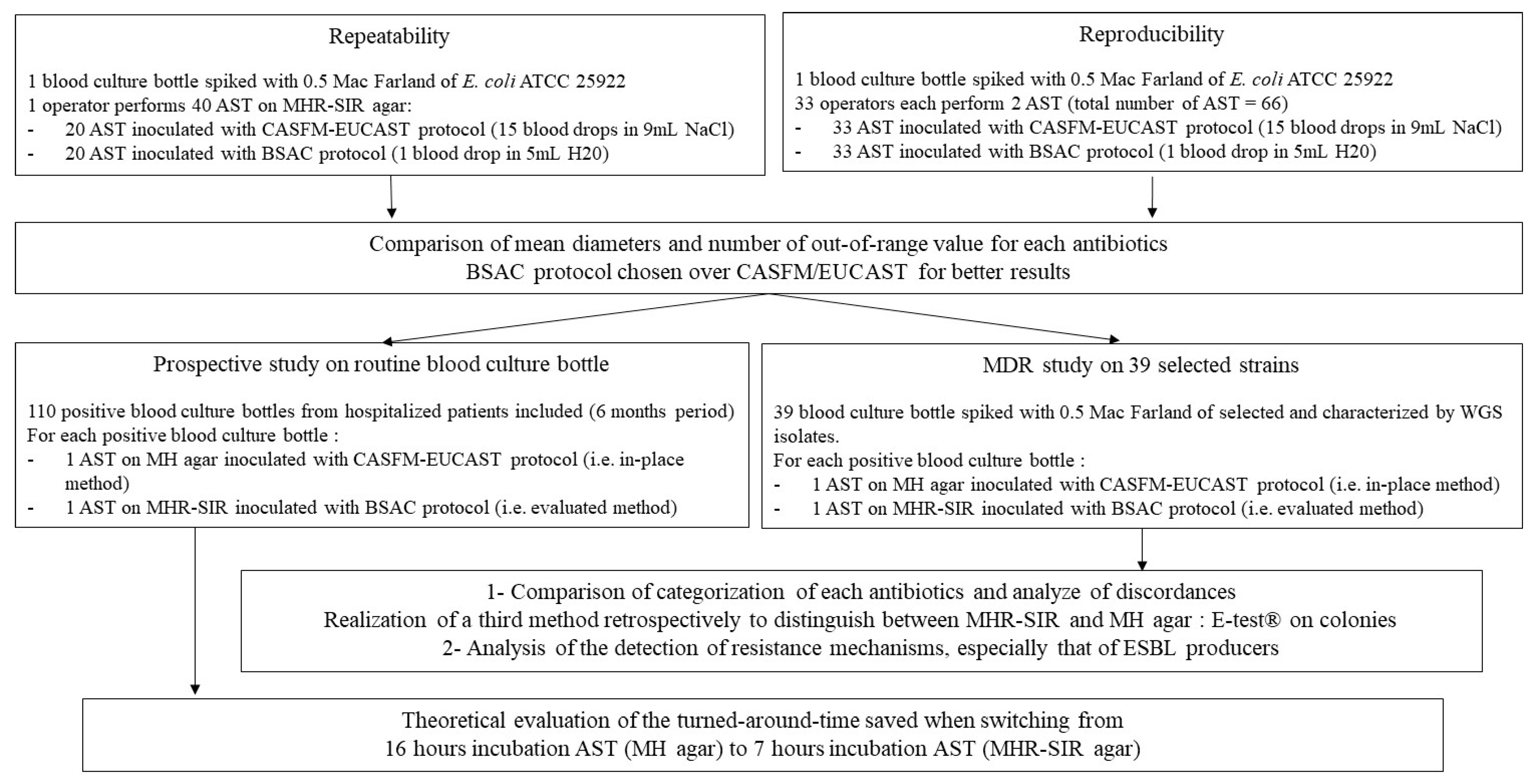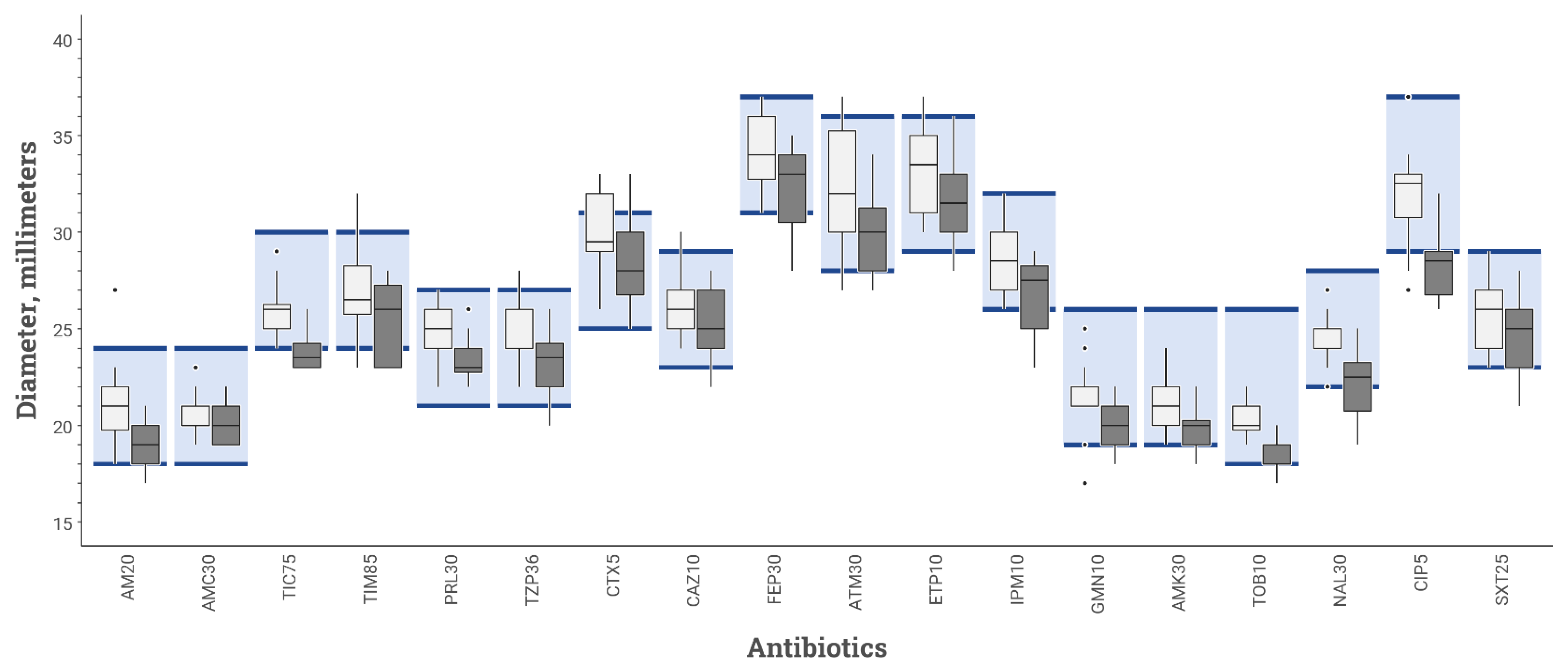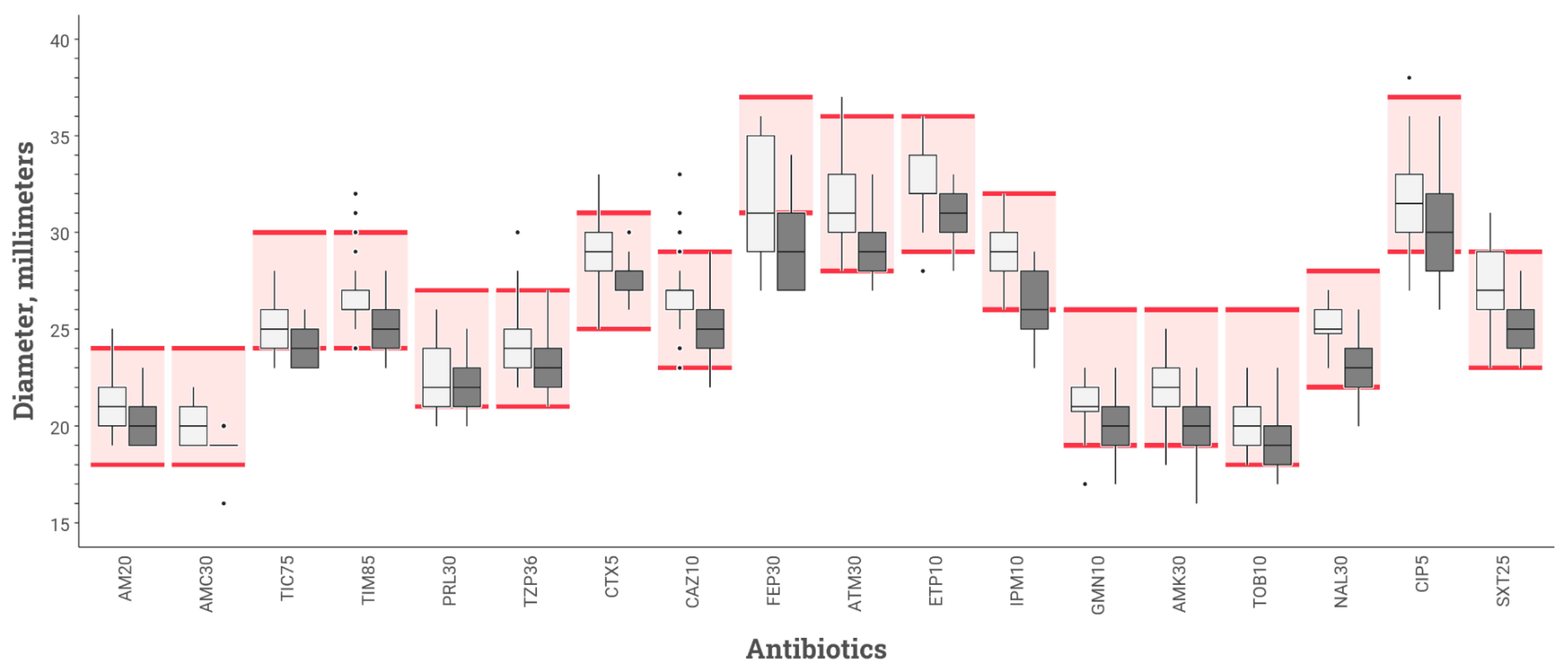Evaluation of an Antibiotic Susceptibility Testing Method on Enterobacterales-Positive Blood Cultures in Less Than 8 h Using the Rapid Mueller-Hinton Diffusion Method in Conjunction with the SIRscan 2000 Automatic Reading Device
Abstract
1. Introduction
2. Material and Methods
2.1. Laboratory Setting and Blood Culture Procedure
2.2. Comparison of AST Performance Directly from BCBs on MHR-SIR Agar Using Two Inoculum Protocols Proposed by the BSAC and CASFM-EUCAST, Respectively
2.3. Prospective Comparison of MHR-SIR vs. MH on Enterobacterales-Positive Blood Cultures
2.4. Evaluation of MHR-SIR Ability to Detect Multidrug-Resistant (MDR) Enterobacterales
2.5. Estimated Reduction in AST TAT When Using Direct MHR-SIR from POSITIVE Blood Cultures
2.6. Statistical Analysis
3. Results
3.1. Comparison of the Performance of AST Directly from BCBs on MHR-SIR Agar Using Two Different Inoculum Protocols Proposed by the BSAC and CASFM-EUCAST, Respectively
3.2. Prospective Comparison of MHR-SIR vs. MH on Enterobacterales Positive Blood Cultures
3.3. Evaluation of MHR-SIR Ability to Detect MDR Enterobacterales
3.4. Estimated Reduction in Antibiotic Susceptibility Testing TAT Using Direct MHR-SIR from Positive Blood Cultures
4. Discussion
5. Conclusions and Outlook
Supplementary Materials
Author Contributions
Funding
Institutional Review Board Statement
Informed Consent Statement
Data Availability Statement
Acknowledgments
Conflicts of Interest
References
- Angus, D.C.; Linde-Zwirble, W.T.; Lidicker, J.; Clermont, G.; Carcillo, J.; Pinsky, M.R. Epidemiology of severe sepsis in the United States: Analysis of incidence, outcome, and associated costs of care. Crit. Care Med. 2001, 29, 1303–1310. [Google Scholar] [CrossRef] [PubMed]
- De Kraker, M.E.A.; Jarlier, V.; Monen, J.C.M.; Heuer, O.E.; van de Sande, N.; Grundmann, H. The changing epidemiology of bacteraemias in Europe: Trends from the European Antimicrobial Resistance Surveillance System. Clin. Microbiol. Infect. Off. Publ. Eur. Soc. Clin. Microbiol. Infect. Dis. 2013, 19, 860–868. [Google Scholar] [CrossRef] [PubMed]
- Rivers, E.; Nguyen, B.; Havstad, S.; Ressler, J.; Muzzin, A.; Knoblich, B.; Peterson, E.; Tomlanovich, M. Early Goal-Directed Therapy in the Treatment of Severe Sepsis and Septic Shock. N. Engl. J. Med. 2001, 345, 1368–1377. [Google Scholar] [CrossRef] [PubMed]
- Shorr, A.F.; Micek, S.T.; Welch, E.C.; Doherty, J.A.; Reichley, R.M.; Kollef, M.H. Inappropriate antibiotic therapy in Gram-negative sepsis increases hospital length of stay. Crit. Care Med. 2011, 39, 46–51. [Google Scholar] [CrossRef]
- Kollef, M.H.; Sherman, G.; Ward, S.; Fraser, V.J. Inadequate Antimicrobial Treatment of Infections. Chest 1999, 115, 462–474. [Google Scholar] [CrossRef]
- Garnacho-Montero, J.; Gutiérrez-Pizarraya, A.; Escoresca-Ortega, A.; Fernández-Delgado, E.; López-Sánchez, J.M. Adequate antibiotic therapy prior to ICU admission in patients with severe sepsis and septic shock reduces hospital mortality. Crit. Care 2015, 19, 302. [Google Scholar] [CrossRef][Green Version]
- Schwaber, M.J.; Navon-Venezia, S.; Kaye, K.S.; Ben-Ami, R.; Schwartz, D.; Carmeli, Y. Clinical and Economic Impact of Bac-teremia with Extended- Spectrum-β-Lactamase-Producing Enterobacteriaceae. Antimicrob. Agents Chemother. 2006, 50, 1257–1262. [Google Scholar] [CrossRef]
- Galar, A.; Leiva, J.; Espinosa, M.; Guillén-Grima, F.; Hernáez, S.; Yuste, J. Clinical and economic evaluation of the impact of rapid microbiological diagnostic testing. J. Infect. 2012, 65, 302–309. [Google Scholar] [CrossRef]
- Jonasson, E.; Matuschek, E.; Kahlmeter, G. The EUCAST rapid disc diffusion method for antimicrobial susceptibility testing directly from positive blood culture bottles. J. Antimicrob. Chemother. 2020, 75, 968–978. [Google Scholar] [CrossRef]
- Humphries, R.; Bobenchik, A.M.; Hindler, J.A.; Schuetz, A.N. Overview of Changes to the Clinical and Laboratory Standards Institute Performance Standards for Antimicrobial Susceptibility Testing, M100, 31st Edition. J. Clin. Microbiol. 2021, 59, e00213-21. [Google Scholar] [CrossRef]
- Périllaud, C.; Pilmis, B.; Diep, J.; Péan de Ponfilly, G.; Vidal, B.; Couzigou, C.; Mizrahi, A.; Lourtet-Hascoët, J.; Le Monnier, A.; Nguyen Van, J.-C. Prospective evaluation of rapid antimicrobial susceptibility testing by disc diffusion on Mueller-Hinton rapid-SIR directly on blood cultures. Diagn. Microbiol. Infect. Dis. 2019, 93, 14–21. [Google Scholar] [CrossRef] [PubMed]
- Wootton, M. BSAC Methods for Antimicrobial Susceptibility Testing; BSAC: Birmingham, UK, 2013. [Google Scholar]
- Simon, L.; Ughetto, E.; Gaudart, A.; Degand, N.; Lotte, R.; Ruimy, R. Direct Identification of 80 Percent of Bacteria from Blood Culture Bottles by Matrix-Assisted Laser Desorption Ionization–Time of Flight Mass Spectrometry Using a 10-Minute Extraction Protocol. J. Clin. Microbiol. 2019, 57, e01278-18. [Google Scholar] [CrossRef] [PubMed]
- CA-SFM. Comité de l’Antibiogramme de la Société Française de Microbiologie: Recommandations 2019 V2.0; SFM: Paris, France, 2019. [Google Scholar]
- Kaur, J. Modified Double Disc Synergy Test to Detect ESBL Production in Urinary Isolates of Escherichia coli and Klebsiella pneumoniae. J. Clin. Diagn. Res. 2013, 7, 229–233. [Google Scholar] [CrossRef] [PubMed]
- Nurk, S.; Bankevich, A.; Antipov, D.; Gurevich, A.A.; Korobeynikov, A.; Lapidus, A.; Prjibelski, A.D.; Pyshkin, A.; Sirotkin, A.; Sirotkin, Y.; et al. Assembling Single-Cell Genomes and Mini-Metagenomes from Chimeric MDA Products. J. Comput. Biol. 2013, 20, 714–737. [Google Scholar] [CrossRef] [PubMed]
- Beyrouthy, R.; Barets, M.; Marion, E.; Dananché, C.; Dauwalder, O.; Robin, F.; Gauthier, L.; Jousset, A.; Dortet, L.; Guérin, F.; et al. Novel Enterobacter Lineage as Leading Cause of Nosocomial Outbreak Involving Carbapenemase-Producing Strains. Emerg. Infect. Dis. 2018, 24, 1505–1515. [Google Scholar] [CrossRef] [PubMed]
- Nordmann, P.; Poirel, L.; Dortet, L. Rapid Detection of Carbapenemase-producing Enterobacteriaceae. Emerg. Infect. Dis. 2012, 18, 1503–1507. [Google Scholar] [CrossRef]
- Coyle, M.B.; McGonagle, L.A.; Plorde, J.J.; Clausen, C.R.; Schoenknecht, F.D. Rapid antimicrobial susceptibility testing of isolates from blood cultures by direct inoculation and early reading of disc diffusion tests. J. Clin. Microbiol. 1984, 20, 473–477. [Google Scholar] [CrossRef]
- Doern, G.V.; Scott, D.R.; Rashad, A.L.; Kim, K.S. Evaluation of a direct blood culture disc diffusion antimicrobial susceptibility test. Antimicrob. Agents Chemother. 1981, 20, 696–698. [Google Scholar] [CrossRef]
- Wegner, D.L.; Mathis, C.R.; Neblett, T.R. Direct Method to Determine the Antibiotic Susceptibility of Rapidly Growing Blood Pathogens. Antimicrob. Agents Chemother. 1976, 9, 861–862. [Google Scholar] [CrossRef][Green Version]
- Fay, D.; Oldfather, J.E. Standardization of direct susceptibility test for blood cultures. J. Clin. Microbiol. 1979, 9, 347–350. [Google Scholar] [CrossRef]
- Sherman, J.M.; Holm, G.E.; Albus, W.R. Salt Effects in Bacterial Growth III. Salt Effects in Relation to the Lag Period and Velocity of Growth. J. Bacteriol. 1922, 7, 583–588. [Google Scholar] [CrossRef] [PubMed]
- Grohs, P.; Rondinaud, E.; Fourar, M.; Rouis, K.; Mainardi, J.-L.; Podglajen, I. Comparative evaluation of the QMAC-dRAST V2.0 system for rapid antibiotic susceptibility testing of Gram-negative blood culture isolates. J. Microbiol. Methods 2020, 172, 105902. [Google Scholar] [CrossRef] [PubMed]
- Gherardi, G.; Angeletti, S.; Panitti, M.; Pompilio, A.; Di Bonaventura, G.; Crea, F.; Avola, A.; Fico, L.; Palazzo, C.; Sapia, G.F.; et al. Comparative evaluation of the Vitek-2 Compact and Phoenix systems for rapid identification and antibiotic susceptibility testing directly from blood cultures of Gram-negative and Gram-positive isolates. Diagn. Microbiol. Infect. Dis. 2012, 72, 20–31. [Google Scholar] [CrossRef] [PubMed]
- Marschal, M.; Bachmaier, J.; Autenrieth, I.; Oberhettinger, P.; Willmann, M.; Peter, S. Evaluation of the Accelerate Pheno System for Fast Identification and Antimicrobial Susceptibility Testing from Positive Blood Cultures in Bloodstream Infections Caused by Gram-Negative Pathogens. J. Clin. Microbiol. 2017, 55, 2116–2126. [Google Scholar] [CrossRef]
- Taplitz, R.A.; Kennedy, E.B.; Bow, E.J.; Crews, J.; Gleason, C.; Hawley, D.K.; Langston, A.A.; Nastoupil, L.J.; Rajotte, M.; Rolston, K.; et al. Outpatient Management of Fever and Neutropenia in Adults Treated for Malignancy: American Society of Clinical Oncology and Infectious Diseases Society of America Clinical Practice Guideline Update. J. Clin. Oncol. 2018, 36, 1443–1453. [Google Scholar] [CrossRef]
- Torres, A.; Niederman, M.S.; Chastre, J.; Ewig, S.; Fernandez-Vandellos, P.; Hanberger, H.; Kollef, M.; Li Bassi, G.; Luna, C.M.; Martin-Loeches, I.; et al. International ERS/ESICM/ESCMID/ALAT guidelines for the management of hospital-acquired pneumonia and ventilator-associated pneumonia: Guidelines for the management of hospital-acquired pneumonia (HAP)/ventilator-associated pneumonia (VAP) of the European Respiratory Society (ERS), European Society of Intensive Care Medicine (ESICM), European Society of Clinical Microbiology and Infectious Diseases (ESCMID) and Asociación Latinoamericana del Tórax (ALAT). Eur. Respir. J. 2017, 50, 1700582. [Google Scholar]
- Gupta, K.; Hooton, T.M.; Naber, K.G.; Wullt, B.; Colgan, R.; Miller, L.G.; Moran, G.J.; Nicolle, L.E.; Raz, R.; Schaeffer, A.J.; et al. International Clinical Practice Guidelines for the Treatment of Acute Uncomplicated Cystitis and Pyelonephritis in Women: A 2010 Update by the Infectious Diseases Society of America and the European Society for Microbiology and Infectious Diseases. Clin. Infect. Dis. 2011, 52, e103–e120. [Google Scholar] [CrossRef]
- Kerlund, A.; Jonasson, E.; Matuschek, E.; Serrander, L.; Sundqvist, M.; Kahlmeter, G.; The RAST Study Group. EUCAST rapid antimicrobial susceptibility testing (RAST) in blood cultures: Validation in 55 European laboratories. J. Antimicrob. Chemother. 2020, 75, 3230–3238. [Google Scholar] [CrossRef]
- Périllaud-Dubois, C.; Pilmis, B.; Diep, J.; de Ponfilly, G.P.; Perreau, S.; Ruffier d’Epenoux, L.; Mizrahi, A.; Couzigou, C.; Vidal, B.; Le Monnier, A.; et al. Performance of rapid antimicrobial susceptibility testing by disc diffusion on MHR-SIR agar directly on urine specimens. Eur. J. Clin. Microbiol. Infect. Dis. 2019, 38, 185–189. [Google Scholar] [CrossRef]
- Eveillard, M.; Lemarié, C.; Cottin, J.; Hitoto, H.; Mahaza, C.; Kempf, M.; Joly-Guillou, M.L. Assessment of the usefulness of performing bacterial identification and antimicrobial susceptibility testing 24 h a day in a clinical microbiology laboratory. Clin. Microbiol. Infect. 2010, 16, 1084–1089. [Google Scholar] [CrossRef]
- Dubourg, G.; Lamy, B.; Ruimy, R. Rapid phenotypic methods to improve the diagnosis of bacterial bloodstream infections: Meeting the challenge to reduce the time to result. Clin. Microbiol. Infect. 2018, 24, 935–943. [Google Scholar] [CrossRef] [PubMed]
- Pilmis, B.; Thy, M.; Diep, J.; Krob, S.; Périllaud, C.; Couzigou, C.; Vidal, B.; Mizrahi, A.; Lourtet-Hascoët, J.; Le Monnier, A.; et al. Clinical impact of rapid susceptibility testing on MHR-SIR directly from blood cultures. J. Antimicrob. Chemother. 2019, 74, 3063–3068. [Google Scholar] [CrossRef] [PubMed]
- Chandrasekaran, S.; Abbott, A.; Campeau, S.; Zimmer, B.L.; Weinstein, M.; Thrupp, L.; Hejna, J.; Walker, L.; Ammann, T.; Kirn, T.; et al. Direct-from-Blood-Culture Disc Diffusion to Determine Antimicrobial Susceptibility of Gram-Negative Bacteria: Preliminary Report from the Clinical and Laboratory Standards Institute Methods Development and Standardization Working Group. J. Clin. Microbiol. 2018, 56, e01678-17. [Google Scholar] [CrossRef] [PubMed]




| Bacteria | Genetic β-Lactam Resistance * | Phenotypic Mechanism |
|---|---|---|
| E. coli | NDM-5, OXA-181, CMY-42 | carbapenemase |
| E. coli | TEM-1, OXA-48 | carbapenemase |
| E. coli | OXA-48 | carbapenemase |
| K. pneumoniae | OXA-1, TEM-1, NDM-5 | carbapenemase |
| K. pneumoniae | CTX-M-15, NDM-1, CMY-2, OXA-1 | carbapenemase, ESBL |
| K. pneumoniae | CTX-M-15, NDM-1, TEM-1, OXA-1, OXA-9 | carbapenemase, ESBL |
| E.cloacae | CTX-M-15, KPC-3 | carbapenemase, ESBL |
| C. freundii | CTX-M-15, OXA-48, OXA-1, OXA-9, AmpC hyperproducter | carbapenemase, ESBL, AmpC hyperproduction |
| C. freundii | CTX-M-15, OXA-48, AmpC hyperproducter | carbapenemase, ESBL, AmpC hyperproduction |
| E.cloacae | SHV-12, AmpC hyperproducter, OXA-48 | carbapenemase, ESBL, AmpC hyperproduction |
| K. oxytoca | SHV-12, TEM-1 | ESBL |
| E. coli | CTX-M-27 | ESBL |
| K. pneumoniae | CTX-M-15, TEM-1, OXA-1, OXA-9 | ESBL |
| E. coli | CTX-M-27, TEM-1 | ESBL |
| E. coli | CTX-M-15, OXA-1 | ESBL |
| E. coli | CTX-M-27 | ESBL |
| K. pneumoniae | CTX-M-15 | ESBL |
| E. coli | CTX-M-14 | ESBL |
| E. coli | CTX-M-14 | ESBL |
| E. coli | CTX-M-27 | ESBL |
| E. coli | CTX-M-15, TEM-1 | ESBL |
| E. coli | CTX-M-15, TEM-30, OXA-1 | ESBL |
| E. cloacae | SHV-12, TEM-1, AmpC hyperproducter | ESBL, AmpC hyperproducer |
| E. cloacae | AmpC | AmpC hyperproduction |
| E. cloacae | AmpC | AmpC hyperproduction |
| E. coli | AmpC | AmpC hyperproduction |
| E. coli | AmpC | AmpC hyperproduction |
| S. marcescens | AmpC | AmpC hyperproduction |
| K. oxytoca | DHA-1 CMY-2 | plasmidic cephalosporinase |
| P. mirabilis | CMY-2 | plasmidic cephalosporinase |
| E. coli | CMY-2 | plasmidic cephalosporinase |
| E. coli | DHA-1 TEM-1 | plasmidic cephalosporinase |
| K. pneumoniae | DHA-1 TEM-1 | plasmidic cephalosporinase |
| K. pneumoniae | DHA-1 | plasmidic cephalosporinase |
| K. pneumoniae | SHV-27 + TEM-1 | Penicillinase hyperproduction |
| K. pneumoniae | SHV-1 | Penicillinase hyperproduction |
| P. mirabilis | HyperTEM-1 (Pa/Pb) | oxacillinase |
| E. coli | TEM-33 | Inhibitor-resistant TEM |
| E. coli | OXA-1 | oxacillinase |
| Antibiotics | Numbers of Out-of-Range Diameters | |||
|---|---|---|---|---|
| CASFM-EUCAST | BSAC | |||
| Repeatability | Reproducibility | Repeatability | Reproducibility | |
| Amoxicillin 20 µg | 3 | 0 | 1 | 0 |
| Amoxicillin-clavulanic acid 30 µg | 0 | 1 | 0 | 0 |
| Ticarcillin 75 µg | 10 | 11 | 0 | 0 |
| Ticarcillin-clavulanic acid 85 µg | 6 | 2 | 1 | 2 |
| Piperacillin 30 µg | 0 | 8 | 0 | 4 |
| Piperacillin-tazobactam 36 µg | 1 | 0 | 1 | 3 |
| Cefotaxime 5 µg | 1 | 0 | 6 | 1 |
| Ceftazidime 10 µg | 2 | 1 | 1 | 3 |
| Cefepime 30 µg | 5 | 22 | 0 | 13 |
| Aztreonam 30 µg | 3 | 4 | 4 | 1 |
| Ertapenem 10 µg | 2 | 1 | 2 | 0 |
| Imipenem 10 µg | 6 | 8 | 0 | 0 |
| Gentamicin 10 µg | 0 | 4 | 1 | 1 |
| Amikacin 30 µg | 3 | 3 | 0 | 1 |
| Tobramycin 10 µg | 3 | 3 | 0 | 0 |
| Nalidixic acid 30 µg | 6 | 4 | 0 | 0 |
| Ciprofloxacin 5 µg | 9 | 9 | 2 | 1 |
| Trimethoprim-sulfamethoxazole 25 µg | 4 | 0 | 0 | 1 |
| Total | 64 | 81 | 19 | 31 |
| Bacterium | β-Lactams Resistance | Type of Discordance | Molecule | MIC (mg/L) E-Test Method | Correct Method |
|---|---|---|---|---|---|
| K. pneumoniae | ESBL producer | VME | trimethoprim-sulfamethoxazole | 32 (R) | MH |
| E. coli | WT | ME | ciprofloxacin | 0.19 (S) | MH |
| E. coli | WT | ME | ciprofloxacin | 0.006 (S) | MH |
| E. coli | Penicillinase | ME | ciprofloxacin | 0.5 (I) | None |
| K. pneumoniae | WT | ME | trimethoprim-Sulfamethoxazole | 0.032 (S) | MHR-SIR |
| S. marcescens | WT | ME | ciprofloxacin | 0.064 (S) | MH |
| E. coli | Penicillinase | me | trimethoprim-sulfamethoxazole | 32 (R) | MH |
| E. coli | ESBL producer | me | ciprofloxacin | 0.19 (S) | None |
| K. pneumoniae | WT | me | ticarcillin-clavulanic acid | 16 (I) | MHR-SIR |
| K. pneumoniae | ESBL producer | me | piperacillin-tazobactam | 48 (R) | MHR-SIR |
| K. pneumoniae | ESBL producer | me | aztreonam | 6 (R) | MH |
| P. mirabilis | WT | me | ciprofloxacin | 0.5 (I) | MH |
| E. cloacae | AmpC hyperproducer | me | piperacillin-tazobactam | 64 (R) | MH |
| E. cloacae | AmpC hyperproducer | me | aztreonam | 12 (R) | MHR-SIR |
Publisher’s Note: MDPI stays neutral with regard to jurisdictional claims in published maps and institutional affiliations. |
© 2022 by the authors. Licensee MDPI, Basel, Switzerland. This article is an open access article distributed under the terms and conditions of the Creative Commons Attribution (CC BY) license (https://creativecommons.org/licenses/by/4.0/).
Share and Cite
Payen, M.; Gaudart, A.; Legueult, K.; Kasprzak, J.; Emery, A.; Mutambayi, G.; Pradier, C.; Robin, F.; Lotte, R.; Ruimy, R. Evaluation of an Antibiotic Susceptibility Testing Method on Enterobacterales-Positive Blood Cultures in Less Than 8 h Using the Rapid Mueller-Hinton Diffusion Method in Conjunction with the SIRscan 2000 Automatic Reading Device. Microorganisms 2022, 10, 1377. https://doi.org/10.3390/microorganisms10071377
Payen M, Gaudart A, Legueult K, Kasprzak J, Emery A, Mutambayi G, Pradier C, Robin F, Lotte R, Ruimy R. Evaluation of an Antibiotic Susceptibility Testing Method on Enterobacterales-Positive Blood Cultures in Less Than 8 h Using the Rapid Mueller-Hinton Diffusion Method in Conjunction with the SIRscan 2000 Automatic Reading Device. Microorganisms. 2022; 10(7):1377. https://doi.org/10.3390/microorganisms10071377
Chicago/Turabian StylePayen, Mathilde, Alice Gaudart, Kevin Legueult, James Kasprzak, Audrey Emery, Grégoire Mutambayi, Christian Pradier, Frédéric Robin, Romain Lotte, and Raymond Ruimy. 2022. "Evaluation of an Antibiotic Susceptibility Testing Method on Enterobacterales-Positive Blood Cultures in Less Than 8 h Using the Rapid Mueller-Hinton Diffusion Method in Conjunction with the SIRscan 2000 Automatic Reading Device" Microorganisms 10, no. 7: 1377. https://doi.org/10.3390/microorganisms10071377
APA StylePayen, M., Gaudart, A., Legueult, K., Kasprzak, J., Emery, A., Mutambayi, G., Pradier, C., Robin, F., Lotte, R., & Ruimy, R. (2022). Evaluation of an Antibiotic Susceptibility Testing Method on Enterobacterales-Positive Blood Cultures in Less Than 8 h Using the Rapid Mueller-Hinton Diffusion Method in Conjunction with the SIRscan 2000 Automatic Reading Device. Microorganisms, 10(7), 1377. https://doi.org/10.3390/microorganisms10071377







